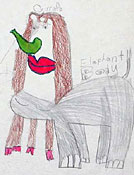

Lesson plan based on Mosaic Floor
Invent, illustrate, and describe hybrid exotic animals, their imaginary origins, and lifestyles.
Skills and Focus: Discussion, Analysis, Hands-on
Subject Area: English Language Arts
Thematic Connection: Animals, Signs and Symbols
Grade Level: Elementary School
Time Needed: 50—75 minutes
Objectives
• Understand the ways in which ancient Romans made use of various animals.
• Create exotic hybrids, combining characteristics of two animals and writing a brief statement about the new creature.
Instructional Materials Needed
Story`: What Animal Is This?
Drawing paper
Crayons, colored pencils, or markers
Print Resources:
• Corbishley, Mike. The Roman World. New York: Warwick Press, 1986.
• James, Simon. Eyewitness Books: Ancient Rome. New York: Alfred A. Knopf, Inc., 1979. pp. 24-25, 28-35.
Online Resources:
• Images of the Colosseum: Encyclopaedia Britannica Online:
http://www.eb.com (search for Colosseum)
Activity
Step 1: After watching the story What Animal Is This?, introduce students to the place of animals in ancient Rome. Animals served many purposes in ancient Roman culture, but most were used for sport, as symbols, or in religious ceremonies. If possible, show some of the images in the James book. Also, distribute the chart.
Step 2: After discussing the chart, turn students’ attention back to the final section of the story in which Dio Cassius describes the giraffe that Caesar brought back to Rome in 46 B.C.
Step 3: Hand out the drawing paper and colored pencils or crayons and ask students to invent and draw their own exotic animal, naming it in the same way that the ancient Romans named the "camelopardus." The animal must be a combination, or hybrid, of at least two animals we are familiar with today, and it must show some attributes of those animals.
Step 4: Have students write a few sentences introducing the animal to an audience gathered at a public arena like the Colosseum. Sentences should name the animal, tell where it came from, and relate interesting facts about the animal's lifestyle, behavior, or personality.
Goals
This activity meets Illinois State Goal 3: Write to communicate for a variety of purposes.
This activity meets Illinois State Goal 4: Listen and speak in a variety of situations.
This activity meets Illinois State Goal 5: Use the language arts for inquiry and research to acquire, organize, analyze, evaluate, and communicate information.
The Place of Animals in Ancient Rome
Sports and Personal Use
Religious or Symbolic Use
lions, tigers • gladiatorial combat
• capital punishment
horses
• contests
• races
bears, giraffes, elephants
• parades
• park displays
wild boars, fish, fowl
• hunting
cats, dogs, insects
• personal pets
Venus and dove, Jupiter and eagle
• association with gods
she-wolf
• founding of Rome
goats, boars, small birds
• sacrificial offerings to gods
© 2000, by The Art Institute of Chicago. All rights reserved. Use of this program is subject to the terms below. No part of this program may be reproduced, transmitted or distributed in any form or by any means, except for personal or classroom use. All Copyright in and to the program, in whole or in part, belongs to the publisher and its licensors and is registered with the U.S. Copyright Office
